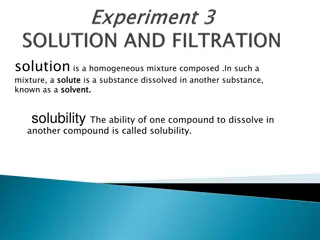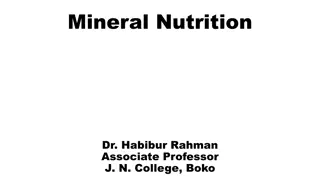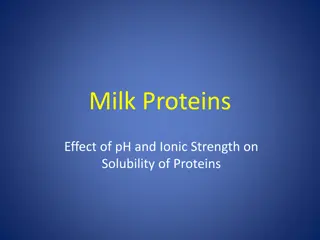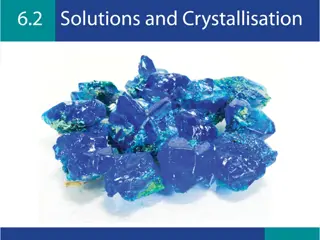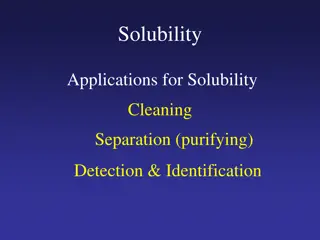Understanding Solubility and Mineral Reactions in Geology
Exploring the complexities of solubility in minerals such as silica, hydroxides, and ferric iron, this informative lecture delves into stability diagrams and the impact of pH on mineral dissolution. Various reactions, equilibrium expressions, and the role of hydroxides in controlling metal solubility are discussed in-depth.
Download Presentation

Please find below an Image/Link to download the presentation.
The content on the website is provided AS IS for your information and personal use only. It may not be sold, licensed, or shared on other websites without obtaining consent from the author. Download presentation by click this link. If you encounter any issues during the download, it is possible that the publisher has removed the file from their server.
E N D
Presentation Transcript
Solubility (cont.); Mineral Surfaces & Reactions Lecture 22
Constructing stability diagrams CO2 = 5x 10-2 M [Fe2+] = 10-6 M This diagram shows the stability of ferrous iron minerals as a function of pH and sulfide for fixed total Fe and CO2. Procedure: manipulate equilibrium constant expressions to obtain and expression for S in terms of pH. For example: o FeCO3+ H+ Fe2++ HCO3 o FeCO3+ 2H2O HCO3-H++ Fe(OH)2 o FeS + 2H2O Fe(OH)2+ H++ HS- Trick: simplify by ignoring species present at low conc. (e.g., CO32-at low pH). (Pyrrhotite) (Siderite) -]-log[Fe2+]= 7.5 pH = logKFeCO3-log[HCO3 -]+13.0 pH = log[HCO3 logSS = pH - pKFeS+ pKFe(OH)2+log(KS+10-pH)
Solubility of SiO2 Silica forms silicic acid (H4SiO4) in solution, which can then dissociate through a series of reactions, e.g., H4SiO4 H3SiO4 + H+ K1 H3SiO4 H2SiO42- + H+ K2 Solubility can be expressed as: [SiO2]T=[H2SiO4] 1-K1 +K1K2 aH+ 2 aH+ where [H4SiO4] is controlled by solubility of either quartz or amorphous silica. As a consequence, its solubility is a function of pH: high only at high pH.
Solubility of Hydroxides The hydroxide is the least soluble salt of many metals. Therefore, it is the solubility of their hydroxides that controls the solubility of these metals in natural waters. Since these dissolution reactions involve OH , they are pH- dependent, and the slope of the solubility curve depends on the valence of the metal (e.g., -3 for Fe3+, -2 for Fe2+, -1 for Ag+).
Solubility of Al(OH)3 Solubility of gibbsite: o Al(OH)3 + 3H+ Al3+ + H2O Kgib=aAl3+ =10-8.1 aH+ However, Al forms hydroxide complexes, e.g.: Al3+ + H2O Al(OH)2+ + H+ The total dissolved Al will be the sum of all Al species in solution: aAl3+T= aAl3+ 1+K1 aH+ +K2 aH+ 2+K3 3+K4 4 aH+ aH+ A consequence of this is that acid rain leads to Al poisoning.
Silicate Solubility We ve looked at the solubility of Si, Al, Fe and other cations in the isolation of simple laboratory-like systems. The real world is usually more complex. Silicate rocks predominate at the surface of the Earth, thus Si, Al, and other cations will generally all be present. In addition to gibbsite and SiO2, some of the more common weathering products of silicate rocks include: kaolinite: Al2Si2O5(OH)4 pyrophyllite: Al2Si4O10(OH)2 illite (muscovite): KAl3Si3O10(OH)2
Silicate Solubility Gibbsite will precipitate from Al-bearing solution only at lowest concentrations of SiO2. Occurrence generally restricted to highly weathered soils where all the SiO2 has washed out.
Clay Minerals Review section 6.5 to become familiar with clay minerals, but we will not cover it in class.
Adsorption and Surface Complexation We can define adsorption as attachment of an ion in solution to a pre-existing solid surface. It involves one or more of the following: Surface complex formation: The formation of coordinative bonds between metals and ligands at the surface, similar to the formation of complexes in solution. Electrostatic interactions: Solid surfaces are typically electrically charged. This electrostatic force, which is effective over greater distances than purely chemical forces, affects surface complex formation and loosely binds other ions to the surface. Hydrophobic adsorption: Many organic substances, most notably lipids, are highly insoluble in water due to their non- polar nature. These substances become adsorbed to surfaces, not because they are attracted to the surface, but rather because they are repelled by water. o This topic is treated in Chapter 12.
Surface Complexation Model Kad[M] 1+Kad[M] QM= The Langmuir Isotherm was QM= Kad[M] and the Freundlich was: The tendency of an ion to be adsorbed to a surface is expressed as an adsorption coefficient, which we can relate to thermodynamics and energy and entropy changes at the mineral surface, i.e., Gad. The surface complexation model incorporates both chemical bonding of solute species to surface atoms and electrostatic interactions between the surface and solute ions. The free energy of adsorption is the sum of a complexation, or intrinsic, term and an electrostatic, or coulombic term: Gad= Gintr+ Gcoul From this it follows that the adsorption equilibrium constant can be written as: Kad = Kintr Kcoul
Surfaces in Water Consider a simple surface such as a metal oxide. Oxygen and metal atoms at an oxide surface are incompletely coordinated hence have partial charge. Consequently, mineral surfaces immersed in water attract and bind water molecules. The water molecules then dissociate, leaving a hydroxyl group bound to the surface metal ions: M+ + H2O MOH + H+ Similarly, unbound oxygens react with water to leave a surface hydroxyl group: O + H2O OH + OH The surface quickly becomes covered with hydroxyls ( SOH), considered part of the surface rather than the solution. These hydroxyls can then act as either proton acceptors or proton donors through further association or dissociation reactions: SOH + H+ SOH2+ SOH SO- + H+ We should not be surprised to find that these kinds of reactions are strongly pH-dependent.
Adsorption Mechanisms Adsorption of metals to the surface may occur through replacement of a surface proton. Ligands may be absorbed by replacement of a surface OH group. The adsorbed metal may bind an additional ligand. The adsorbed ligand may bind an additional metal. An additional possibility is multidentate adsorption, where a metal or ligand is bound to more than one surface site.
Multidentate Adsorption raises an interesting dilemma for the Langmuir isotherm. Where x sites are involved, we could write the reaction: x S + M SxM Writing an equilibrium constant expression for this reaction would imply that the probability of finding x sites together is proportional to the xth power of concentration, which is not the case. A better approach is to assume that the reaction occurs with a multidentate surface species, Sx and that its concentration is [ S]/x. The equilibrium constant is then: Kad= [M][ S]/ x [ SxM]
Cation pH dependence Adsorption of metals and ligands will be strongly pH-dependent. Adsorption of cations increases with increasing pH. The figure shows that adsorption of metals on goethite goes from insignificant to nearly complete over a very narrow range of pH. This reflects protonation of the surface, but it also reflects the extent of hydrolysis of the ion in solution. Metals vary greatly in how readily they are adsorbed. At a pH of 7, for example, and a solution containing a 1 M concentration of the metal of interest, the fraction of surface sites occupied by Ca, Ag, and Mg is trivial and only 10% of surface sites would be occupied by Cd. At this same pH, however, 97% of sites would be occupied by Pb and essentially all sites would be occupied by Hg and Pd.
Anion pH dependence Adsorption of anions decreases with increasing pH. Extend of adsorption also depends on the nature of the ligand.
Inner & Outer Sphere Complexes As is the case with soluble complexes, surface complexes may be divided into inner sphere and outer sphere complexes. Inner sphere complexes involve some degree of covalent bonding between the adsorbed species and atoms on the surface. In an outer sphere complex, one or more water molecules separate the adsorbed ion and the surface; in this case adsorption involves only electrostatic forces. The third possibility is that an ion may be held within the diffuse layer (which we ll get to shortly) by long-range electrostatic forces.




